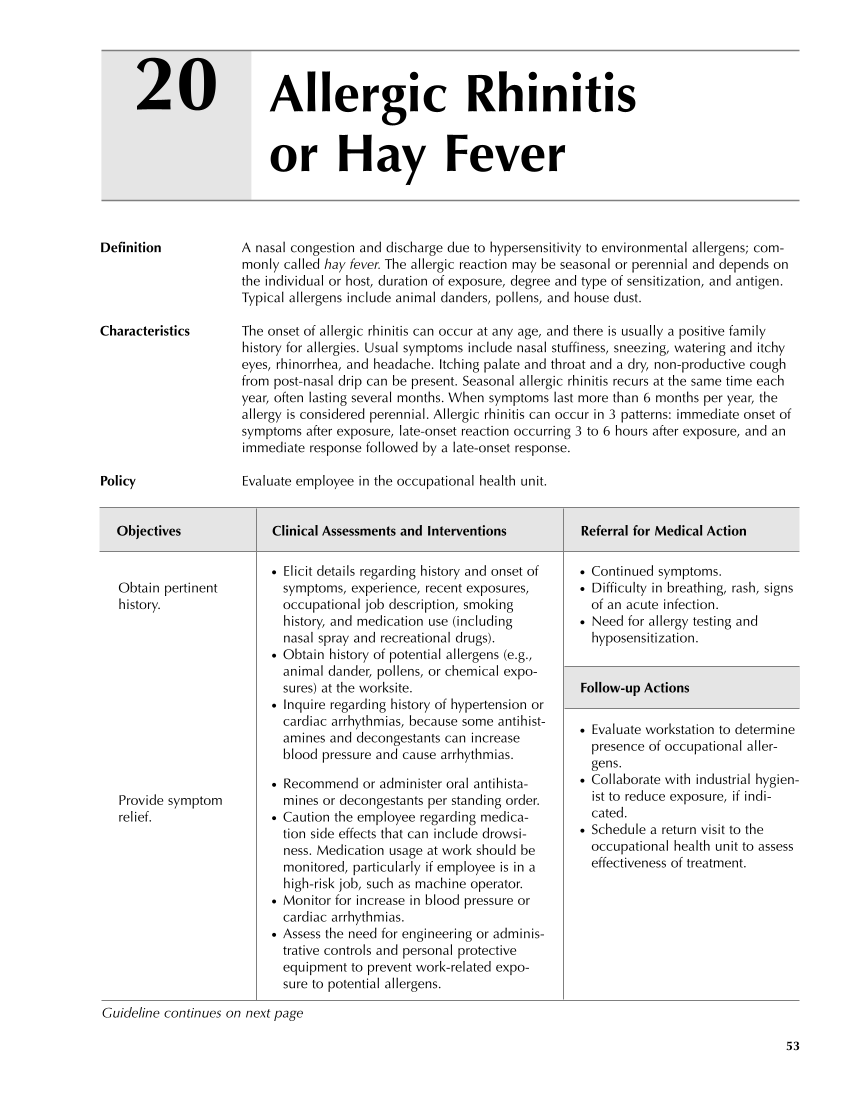53 Allergic Rhinitis or Hay Fever 20 ● Continued symptoms. ● Difficulty in breathing, rash, signs of an acute infection. ● Need for allergy testing and hyposensitization. Follow-up Actions ● Evaluate workstation to determine presence of occupational aller- gens. ● Collaborate with industrial hygien- ist to reduce exposure, if indi- cated. ● Schedule a return visit to the occupational health unit to assess effectiveness of treatment. Obtain pertinent history. Provide symptom relief. ● Elicit details regarding history and onset of symptoms, experience, recent exposures, occupational job description, smoking history, and medication use (including nasal spray and recreational drugs). ● Obtain history of potential allergens (e.g., animal dander, pollens, or chemical expo- sures) at the worksite. ● Inquire regarding history of hypertension or cardiac arrhythmias, because some antihist- amines and decongestants can increase blood pressure and cause arrhythmias. ● Recommend or administer oral antihista- mines or decongestants per standing order. ● Caution the employee regarding medica- tion side effects that can include drowsi- ness. Medication usage at work should be monitored, particularly if employee is in a high-risk job, such as machine operator. ● Monitor for increase in blood pressure or cardiac arrhythmias. ● Assess the need for engineering or adminis- trative controls and personal protective equipment to prevent work-related expo- sure to potential allergens. Guideline continues on next page Definition A nasal congestion and discharge due to hypersensitivity to environmental allergens com- monly called hay fever. The allergic reaction may be seasonal or perennial and depends on the individual or host, duration of exposure, degree and type of sensitization, and antigen. Typical allergens include animal danders, pollens, and house dust. Characteristics The onset of allergic rhinitis can occur at any age, and there is usually a positive family history for allergies. Usual symptoms include nasal stuffiness, sneezing, watering and itchy eyes, rhinorrhea, and headache. Itching palate and throat and a dry, non-productive cough from post-nasal drip can be present. Seasonal allergic rhinitis recurs at the same time each year, often lasting several months. When symptoms last more than 6 months per year, the allergy is considered perennial. Allergic rhinitis can occur in 3 patterns: immediate onset of symptoms after exposure, late-onset reaction occurring 3 to 6 hours after exposure, and an immediate response followed by a late-onset response. Policy Evaluate employee in the occupational health unit. Objectives Clinical Assessments and Interventions Referral for Medical Action
Purchased from OEM Press by (ge corporate access). (C) 2013 OEM Health Information, Inc. All rights reserved.












































































































































































































































































































































































































































